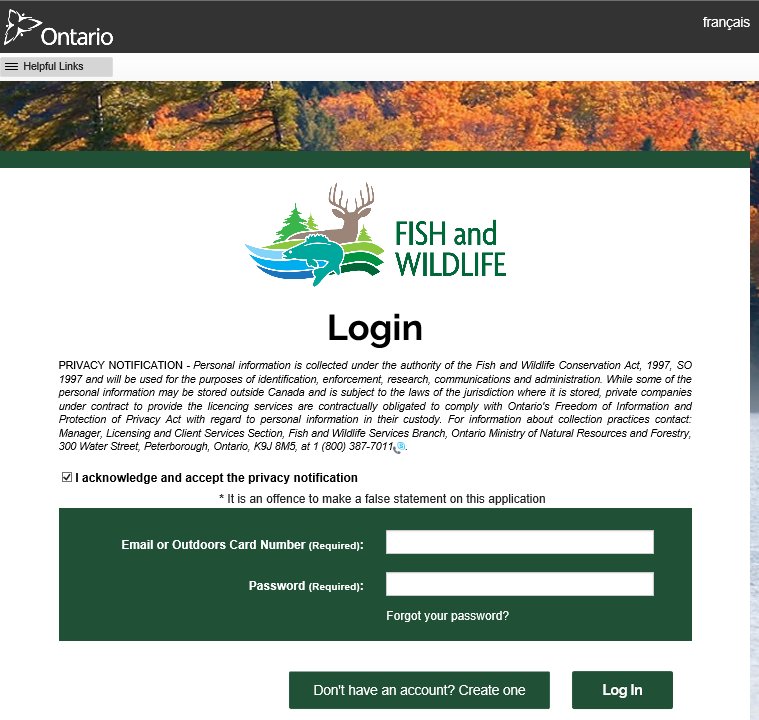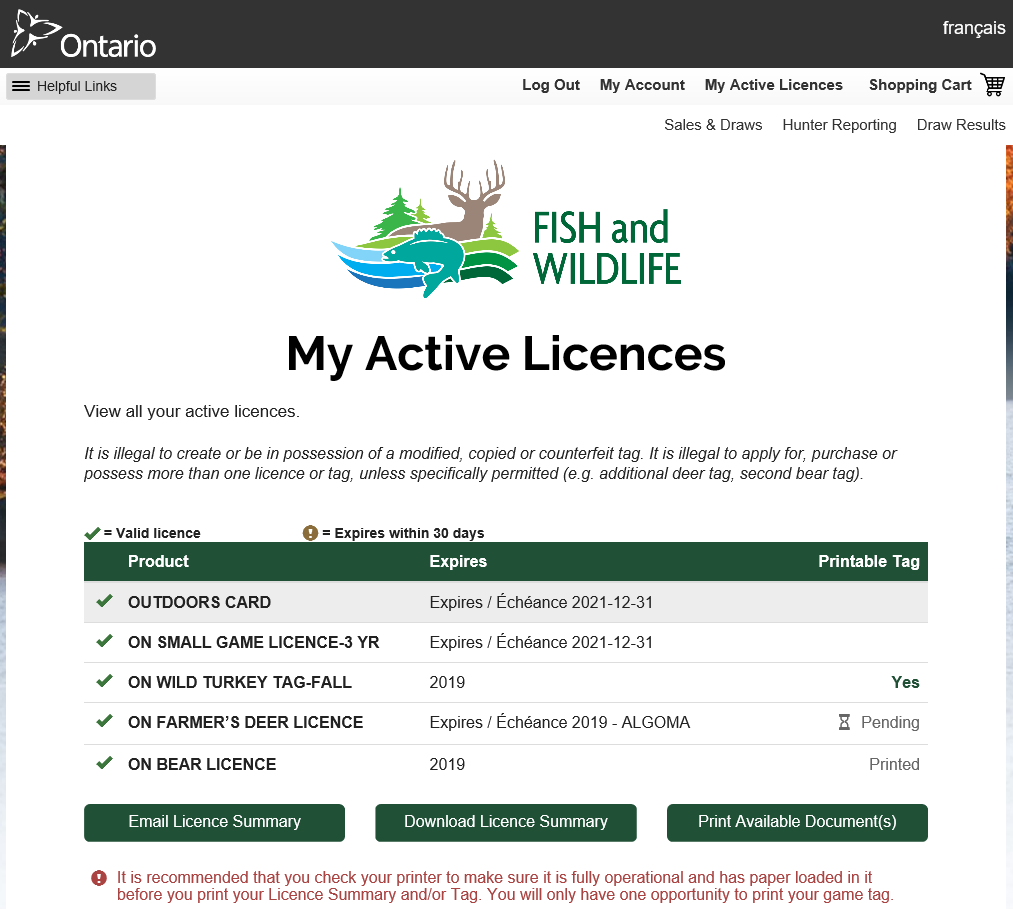Hunting notices and updates
Updates for hunters, including improvements to moose management, big game opportunities and considerations for eating wild game.
Apply to hunt big game in 2023
- Antlerless deer: March 1 to June 30, results available August 1.
- Controlled deer: July 1 to July 31, results available September 1.
- Moose primary allocation: April 1 to May 1, results available May 16.
- Moose second chance allocation: June 15 to July 7, results available August 1.
- Elk: April 15 to June 12, results available August 1.
Earlier controlled deer hunt application period and draw
The application period for the controlled deer hunt draw is changing and the results will be released earlier.
Starting in 2023, the following dates will be earlier:
- the controlled deer draw application period will be open from July 1–31
- draw results will be made available on September 1, almost six weeks earlier than in previous years
- additional controlled deer tags will be available starting September 8
- farmer and landowner controlled deer hunt validations will also be available starting July 1
This change will not impact deer management strategies in Ontario but will hopefully make planning and organizing a little easier for hunters.
Highly Pathogenic Avian Influenza
In the spring of 2022, a number of wild birds of several species were confirmed to have Highly Pathogenic Avian Influenza (HPAI) across southern Ontario.
HPAI was also detected in migratory species in all four flyways (migration corridors) in North America.
HPAI is a highly contagious virus that can infect birds, including:
- waterfowl
- shorebirds
- raptors
- corvids (crows and ravens)
- game bird species
- domestic flocks such as chickens, turkeys and quail
While the risk of human infection with avian influenza viruses is low, you should use caution when handling wild birds. Read the precautions for bird banders, aviculturists and wildlife rehabilitation centres published by the Public Health Agency of Canada.
If you encounter a sick or dead wild bird, report it to the Canadian Wildlife Health Cooperative by phone at
White-tailed deer season map
Our interactive white-tailed deer season map is an easy way to view, save and print customized information from the white-tailed deer hunting season tables.
Learn more and explore at: White-tailed deer seasons
We hope you enjoy the benefits of this new platform as we continue to explore new ways to modernize and enhance how we communicate about provincial hunting seasons.
Improvements to moose management
During the moose management review in 2019, we heard from people across Ontario who wanted moose hunting to be fairer and more sustainable. Learn more about the changes made in 2020 and 2021.
The moose tag draw was being replaced by a points-based tag allocation process in 2021. Learn more about how moose tags are distributed to resident hunters.
Apply to the moose tag allocation process starting April 1.
Moose tag quotas
Find resident moose tag quotas and hunt codes you’ll need to apply to the points-based allocation process at ontario.ca/moosequotas.
How to print your tags
Please ensure your printer is connected to your device and is fully operational with paper loaded before you print your licence summary and tag(s). Please set your printer to print single-sided only. You will only have one opportunity to print your tags at home.
Step 1: login to your account
- Visit the Fish and Wildlife Licensing Service and login to your online account.

Step 2: My Active Licences
- Select My Active Licenses link, which is located at the top of the page.
- The print indicators found under the Printable Tag column include:
- Yes indicates that the tag is available for printing
- Pending indicates that a purchased tag that is not yet available for printing
- Printed indicates a tag that has been printed

Step 3: print your tags
- Select the Print Available Documents
- A current licence summary and available tags will display as a PDF and will open in a separate tab or window.
- Select Print from the opened window.
Get detailed step-by-step instructions on how toprint your tags online from your home.
Keeping chronic wasting disease out of Ontario
Chronic wasting disease (CWD) is a fatal and untreatable disease which affects members of the deer (cervid) family including:
- white-tailed deer
- elk
- moose
- caribou
CWD has not been detected in Ontario wild cervids, but it is important to be vigilant. We are taking measures to help prevent CWD from coming into Ontario. Some of these measures are new as of January 1, 2021, including:
- restrictions on importing and moving live cervids
- restrictions on importing cervids hunted outside of Ontario
- making the use and possession of natural lures and attractants made from cervids illegal
Learn more about how we are keeping CWD out of Ontario.
Black bear changes
Black bear hunter reporting
As of 2021, resident black bear hunters must provide information on all their hunting activity and harvest for the year in a single report. This report is due December 14.
Bear hunters must not submit their report until they are done hunting for the year. You should make note of your spring hunting activities, observations and harvest to make sure you are providing accurate information.
Learn more about mandatory hunter reporting.
Black bear hunting services
As of 2021, any person who wants to provide black bear hunting services (such as guiding or baiting) to resident hunters in a Bear Management Area (BMA) must possess a licence to provide black bear hunting services which allows them to provide services within that BMA.
There can only be one licence holder per BMA. Contact your local ministry work centre for more information.
As of 2021, all non-residents, including those who own property or who are hunting with an immediate relative, are required to hunt through an operator licensed to provide black bear guiding and hunting services.
Learn about hunting black bear with a licensed bear operator.
2024 black bear second tag information
| WMU | Number of second tags available | District | Region |
|---|---|---|---|
| 1C | 10 | Far North | Northwest |
| 2 | 5 | Red Lake-Sioux Lookout | Northwest |
| 11B | 5 | Thunder Bay-Ignace | Northwest |
| 13 | 35 | Thunder Bay-Ignace | Northwest |
| 14 | 5 | Nipigon-Geraldton | Northwest |
| 16A | 10 | Far North | Northwest |
| 16C | 10 | Thunder Bay-Ignace | Northwest |
| 17 | 10 | Nipigon-Geraldton | Northwest |
| 18B | 5 | Nipigon-Geraldton | Northwest |
Field dressing, transporting and preparing wild game
Hunters are reminded to ensure proper handling of their harvested game to ensure a quality food product for the table. Please visit the Ontario Hunter Education Program webpage on field dressing, transporting and preparing wild game for more information and helpful tips on proper handling techniques.
Harvested animals with ear-tags
If you harvest an animal that is wearing an ear-tag with the phone number
Cadmium
The ministry recommends that people not eat the liver and kidneys of moose, deer, and elk because of concerns about cadmium levels in these internal organs.
Lead
Recent research has indicated that the amount of lead found in a small percentage of game meat could result in health impacts in people who regularly consume meat which was harvested using lead ammunition. To date, there is no known evidence linking consumption of wild game to acute lead poisoning.
Exposure to lead can be reduced by:
- Avoiding meat with excessive shot damage and trimming generous distances around wound channels while processing game.
- Using non-lead ammunition.
- Practicing marksmanship to avoid penetrating major muscle areas. Aim for vital organs on big game.
- Avoiding consumption of internal organs.